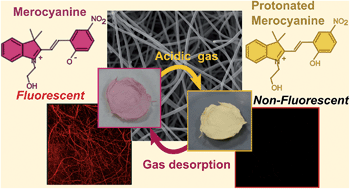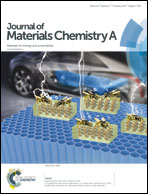Acidochromic fibrous polymer composites for rapid gas detection†
Abstract
The fabrication of spiropyran-doped poly(vinylidene fluoride-co-hexafluoropropylene) electrospun fibers and the investigation of their optochemosensing properties when exposed to organic acid vapors are reported. The system is first activated through the conversion of the spiropyran molecules dispersed within the polymer to their fluorescent merocyanine photoisomers upon UV irradiation. The latter undergo protonation in the presence of acid vapors, giving rise to an evident colorimetric transition of the composite from purple to yellow and to a concurrent quenching in the spectral emission. Upon gas depletion under ambient conditions, the reversible interactions with the acid molecules lead to a spontaneous recovery of the free merocyanine form and, thus, of the initial materials' color and emission signal. Consistent with their higher surface to volume ratio, the nanofibrous mats exhibit a reduction in the response and recovery times by 25% and by more than 90% compared to composite fibers and films of the same material. The efficient vapor permeation/desorption confers a fast optical detection, which is linear with the acid concentration, and an outstanding reusability for over 40 protonation/recovery cycles. Therefore, the photoswitchable acidochromism of spiropyrans combined with the high specific surface area of the nanofibrous polymeric support provides a photoactivated fast optical and visual acid recognition suitable for integration within portable and reusable platforms targeting the real-time detection of acidic vapors for industrial and environmental applications.



 Please wait while we load your content...
Please wait while we load your content...